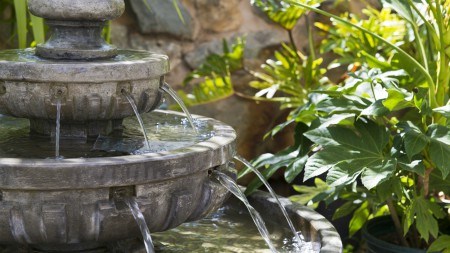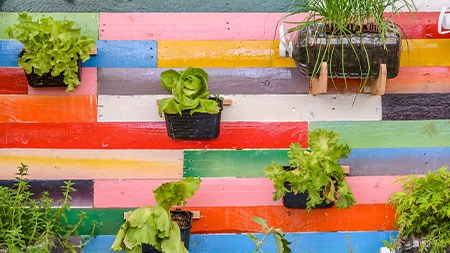Why you should install water features and how to go about it.
Water features are a great addition to urban gardens, providing a much-needed source of water for wild birds and other small animals that live among us.
Running water also has a soothing effect, and even a tiny fountain or waterstone will add to your enjoyment of your garden. Or, you can create a still water feature with a couple of aquatic plants and a goldfish or two to keep the mosquito larvae at bay.
Types of water features
The smallest of outdoor spaces can be enhanced by a water feature. All you need is a suitable vessel and a small pump to circulate the water. A wall-mounted feature with water pouring into a narrow trough or rectangular container works well in a narrow space.
Installing a water feature is easy, and there are countless DIY ideas for doing this on the internet.
- Create a table top water feature by filling a ceramic vessel with water and adding some floating lilies or other aquatic plants.
- Two or more stacked vessels with pumped water create a relaxing water flow, and a place for birds to visit.
- A simple pot or urn can make a striking water feature, but make sure the vessel is designed to remain outdoors in all weather conditions.
Consider this
Before you invest in a garden water feature, you should consider the following:
- Listen to the water feature before you buy. If it sounds like a bath filling it won't be relaxing, and if it's just a slow trickle, it might be annoying rather than soothing.
- Modern features like stainless steel and glass generally work well in modern gardens or traditional ones, whereas older styles like cherubs and millstones tend to look out of place in modern gardens.
- When you are deciding where to install your feature, be aware of what's above it. If it's under a tree, for instance, falling leaves will almost certainly be a problem and will mean more maintenance.
- Water features nestled in among plants are more attractive than in the middle of an open space, regardless of the size.
- Installing small submersible lights in the water work well if there is no inbuilt light. If the feature is in sight of the house this will be attractive throughout the year.
- If you have children consider their safety before choosing a water feature. Small children can drown in tiny amounts of water, so it's advisable to buy a feature with no exposed water, such as a water stone.
How water features work
All running water features work in the same way. There's a reservoir of water (a sump) with a submerged pump that moves water up a pipe or hose, carrying the water to the fountain piece where the water flows out. The water is continuously recirculated while the pump motor is running. Your fountain shouldn't use more electricity than an average size lamp, and it is harder on the pump if it is continually turned on and off. You should never need to turn your fountain off as long as there is enough water in the system to keep the pump from overheating.
Solar power
Water features with running water will need an electricity supply to drive the pump. They can be wired into the mains or solar powered.
In most cases, the solar panel will be connected directly to the water pump. When exposed to sunlight, the panel generates a voltage which is directed towards the pump, powering the submerged impeller to produce the fountain of water. A rechargeable battery stores electric energy during the day to operate the pump when there is no sun.
You need to install the solar panel in an area of the garden that enjoys a lot of sun, preferably facing south. Try to find a place close to the fountain where the panel is almost invisible, such as a south-facing wall or the southern slope of the roof.
Choosing a pump
Selecting a pump for your pond or fountain involves more than just choosing a particular style or design. Submersible fountain pumps come in many sizes and you should choose them based on how much water your water feature holds and lifts within a given period.
The size of the pump depends on how much water needs to pass through the pump – measured in litres per second - and on the head – the difference in height between the lowest parts of the fountain to the highest part, which is measured in metres.
Most small fountains and ponds require a simple submersible pump, designed to recirculate 225 litres an hour or less. Larger ponds with fountains or waterfalls need a more robust pump.
Maintenance
Water features need regular cleaning and care. Water will get slimy, especially during the winter, so you'll need to know how to drain it, dismantle it and clear out the sump, as well as clean the pump filters.
Water usage
Water feature contribute substantially to the overall appearance of a garden and provide an essential service for small animals. However, they do use water and in a country like South Africa that is short of water it’s important to avoid wastage.
Water features need topping up when water is lost due to evaporation. Water is scarce and prices are high, so water loss must be considered when installing water features.




